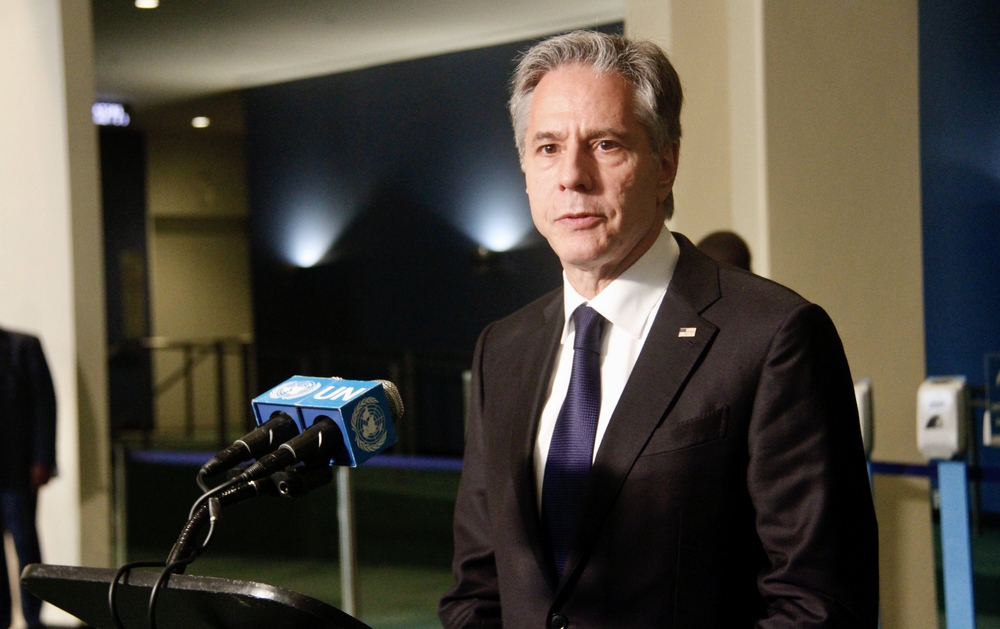There are a number of questions that could be asked about U.S. Secretary of State Antony Blinken singing “Rockin’ in the Free World” in a bar in Kiev. The first is regarding the appropriateness of singing a song while hundreds of Ukrainian soldiers are being wounded or killed every day in a new Russian push. The second is regarding why Blinken was relaxing in a bar instead of attending all night meetings when the war that the United States encouraged Ukraine to fight instead of exploring a diplomatic settlement has gone so wrong.
But the most important question may be whether Blinken got the words wrong.
At a joint press conference with Ukrainian Foreign Minister Dmytro Kuleba in Kiev on May 15, the first question posed to Secretary Blinken was about restrictions on long range missiles provided to Ukraine by the United States. “The Biden administration has made clear it doesn’t want Ukraine using U.S. equipment to strike onto Russian territory,” The Washington Post reporter began. “Does that ban make sense right now and are you considering relaxing it?
Blinken’s response seemed slippery. “We have not encouraged or enabled strikes outside of Ukraine,” Blinken said, seemingly confirming the reporter’s statement about the clarity of U.S. restrictions on the long range missiles they supply. “[B]ut ultimately Ukraine has to make decisions for itself about how it’s going to conduct this war,” he then added, seemingly refuting the reporter’s statement.
Just in case Blinken misspoke, a second reporter repeated the question. “You said,” the reporter clarified, “that the USA would not either ban or encourage the use of American armaments for hitting the Russian territory.” This time the reporter clearly included that the U.S. would not “ban…the use of American armaments for hitting the Russian territory.” And, again, Blinken said, “We’ve been clear about our own policy, but again, these are decisions that Ukraine has to make, Ukraine will make for itself.”
If it is Ukraine’s decision whether to conduct the war by striking outside Ukraine, then that implies that there is no restriction imposed by the United States on the use of its long range missiles. That suggests that, though the U.S. may not be encouraging or enabling strikes into Russian territory, they are not forbidding it either.
And Blinken may have been a little liberal in his use of the word “enable.” Though Ukraine wants the U.S. to provide more intelligence on the locations of Russian troops and military targets inside Russia, The New York Times reports that “The United States provides some intelligence to Ukraine on Russian forces in Russia, for example, on troops that are massing for potential attacks.”
More suggestively, the April 20 passing of the $61 billion aid package for Ukraine, which included the promise of more long-range ATACMS missiles “as soon as practicable” was accompanied by a Pentagon comment that the United States was “considering sending several additional advisors” to Ukraine to “support logistics and oversight efforts for the weapons the U.S. is sending Ukraine” and to help “the Ukrainians plan sustainment of complex equipment donated by the U.S.”
But since Blinken’s visit to Kiev, there have been reports that a high ranking Ukrainian delegation that visited Washington has been rebuffed by the U.S. in their request to have the ban on using U.S. long-range missiles to strike targets inside Russia lifted.
The New York Times says that, in order “to avoid escalating the war,” the United States has “insisted they do not want U.S. weapons used in cross-border attacks or their intelligence reports used to target sites in Russia.” But they also report that “administration officials have begun to review” the most recent such Ukrainian request. According to the Times, “White House officials said the administration’s longstanding policy remained unchanged.” But, in support, they offer the line, “The United States is not encouraging or enabling attacks inside Russia.” That is the exact line offered once by Blinken and then a second time in clarification. And it is not a clear support for the claim that the U.S. is banning the use of their long-range missiles to strike inside Russian territory. Though they continue not to encourage or enable that use of American missiles does not mean that they are banning it. “These are decisions that Ukraine has to make, Ukraine will make for itself,” Blinken said.
On May 2, British Foreign Secretary David Cameron similarly suggested that Ukraine will be able to use British long-range weapons to strike targets inside Russia. “Ukraine has that right. Just as Russia is striking inside Ukraine, you can quite understand why Ukraine feels the need to make sure it’s defending itself,” Cameron said.
Did Blinken’s statement represent an escalatory shift in American policy or were his remarks at the press conference as inappropriate as his singing on the stage of the Kiev bar? The American media says that Washington’s policy has not changed and that the ban has not been lifted. But they offer no real evidence and no direct quotes. And the quote they do offer sounds a lot like the quote that Blinken gave.
The war is going very badly for Ukraine. The United States could try to weakly address that situation by liberating Ukraine to fire away with U.S. long-range missiles. But a similar British threat has already prompted Russia to warn that they could strike “any British military facilities and equipment on the territory of Ukraine and beyond” in retaliation. And Russian President Vladimir Putin has recently suggested that the offensive in the north in the Kharkiv region was launched in order to push Ukraine back and create a security zone because of shelling into “residential neighborhoods in border areas” inside Russia.
The United States could try to fix the problem in Ukraine on the battlefield with escalations that could lead to further Russian escalations. That might address American goals. But, as Russia’s recent pouring through the front in the north, at least in part, in response suggests, it might not benefit Ukraine. Or the U.S. could seek a way out of the escalatory cycle and encourage Ukraine to return to the negotiating table that held such promise in the early days of the war before all the dangerous escalation.
































